With stripes the blue of the ocean and the white of cresting waves, the Cornishware filling my hutch has all the coastal spring and summer vibes!
A New Hutch Display
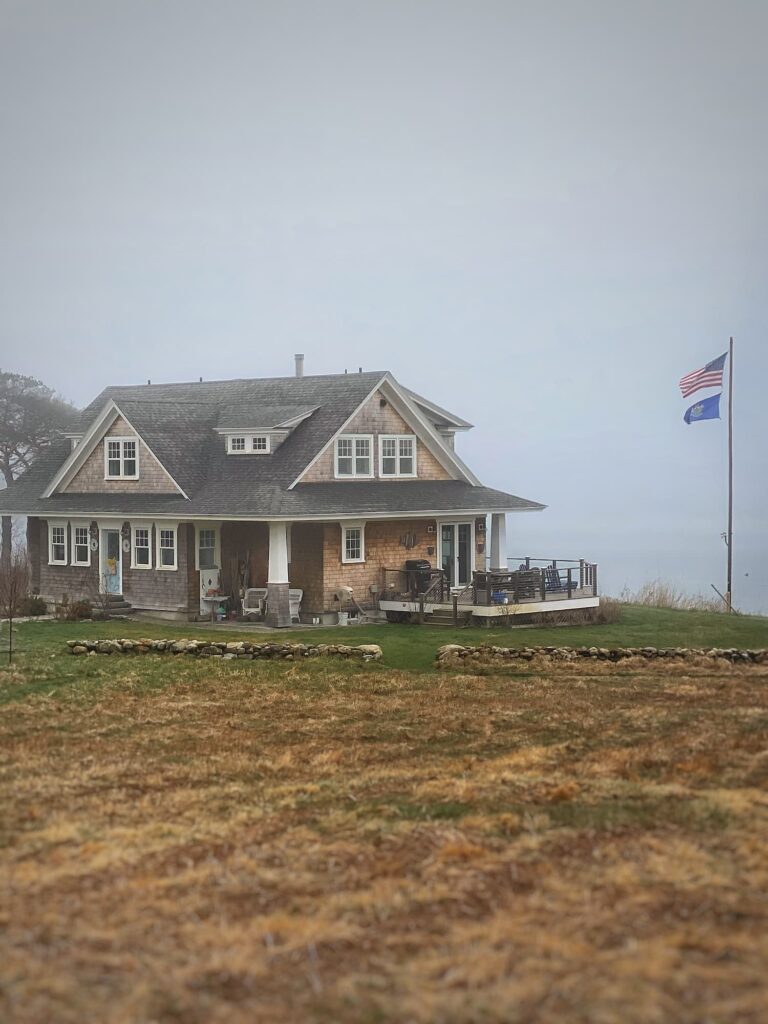

I tend to get really grumpy about the weather here this time of year.
In fact, April just might be my least favorite month of the year.
Yes, you heard me right.
April here seems to be chilly and gray on repeat.
You see, that big wet weather-maker out my windows (aka, the ocean) is just 40˚ right now. And it keeps us pretty firmly planted in the 40’s most days. A day in the low 50’s is a gift!
There are a few small signs of spring outside. The grass is starting to green up. Some daffodils are blooming. The forsythia should pop in a couple weeks. The lupines have broken ground in the field. And of course the weeds are already starting to stake their claim on my flower beds.
But I want more! So, while I usually take my decorating cues from what is happening outside, right now I can’t help adding spring to the house (and even skipping right to summer sometimes).
It is actually spring, after all. It just doesn’t feel much like it.
So, on Sunday, when it was cold and gray, I busied myself filling our big pine hutch with my collection of Cornishware.
With its stripes the blue of the ocean and the white of cresting waves, Cornishware has all the coastal spring and summer vibes!
But wait, do you know what Cornishware is??
What is Cornishware?
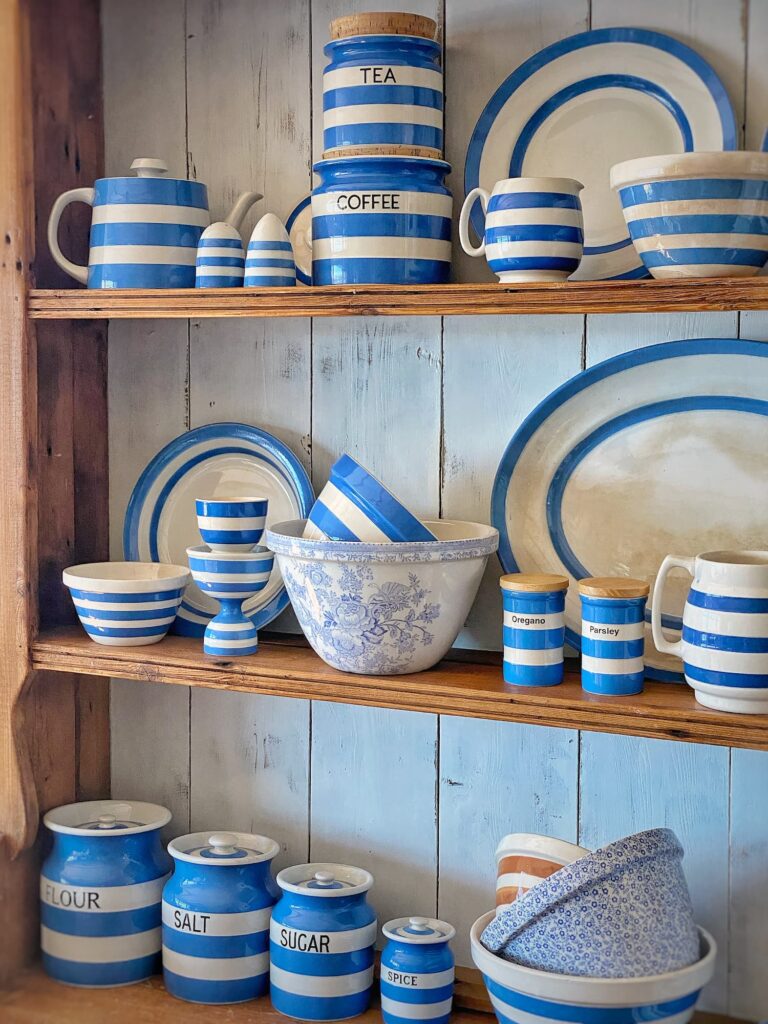
Cornishware is iconic striped pottery made by the British company T.G. Green. They produce it all — plates, bowls, serving dishes, mugs, pitchers, tea and coffee pots, egg cups, and more! These days they even make dog and cat feeding bowls!
They are probably best known, though, for their distinctively-shaped storage jars in varying sizes, with black lettering indicating the contents.
I favor their original blue and white colorway, but Cornishware now comes in red, green, yellow, black, pink, orange, and other specialty colors. The newest color is Blackberry, a purple hue created for Queen Elizabeth’s platinum jubilee, and now made permanent due to popular demand.
The Cornishware Story
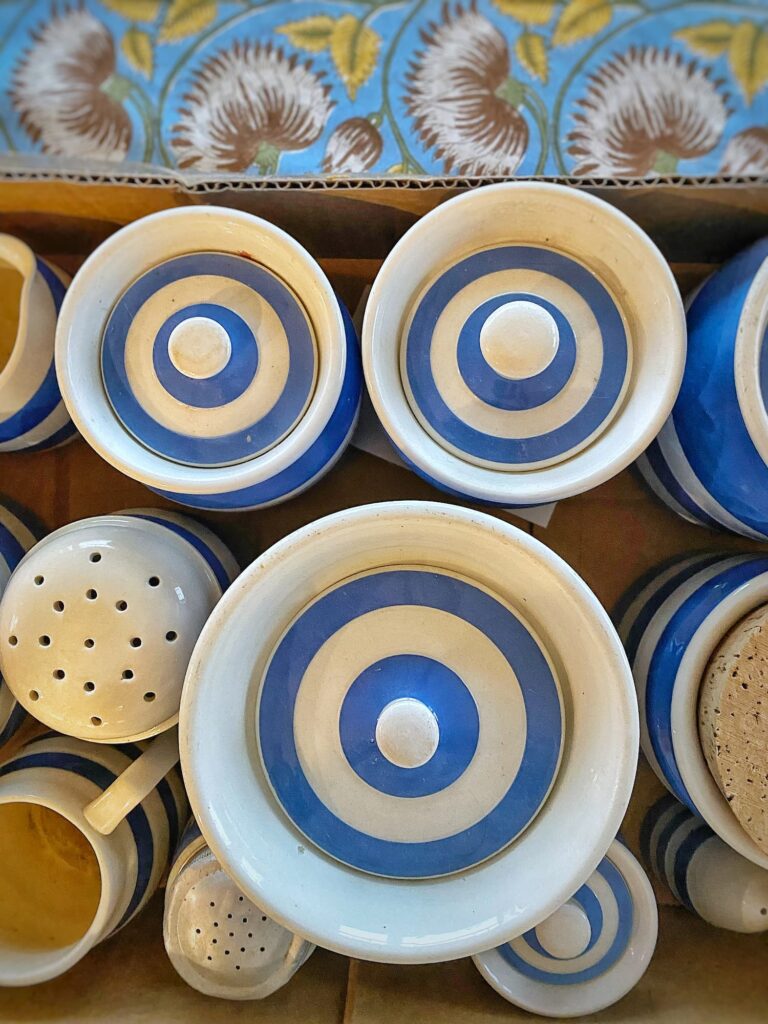
T.G. Green, named for founder Thomas Goodwin Green, began production of the happy blue and white striped Cornishware I love so well in the early 1920’s. Though Cornishware’s only connection to Cornwall is that a Cornish quarry is the source of the clay used to make it, legend has it that the “blue of the Cornish skies and the white crest of the waves” inspired the pottery’s name and signature colors. One advertisement described it similarly: “Blue of the Atlantic — White of the Cornish Clouds — Glisten of the Sea”
Cornishware quickly grew in popularity, and sold well for decades, through the ebb and flow of social and economic tides. But towards the end of the 20th century, T.G. Green began to struggle seriously due to competition from overseas manufacturers and a lack of investors.
In 2007, the company closed, only to be resurrected in 2008 by new owners. The new company moved manufacturing overseas, with the intention of eventually bringing it back to Britain.
Full repatriation was achieved in 2021, meaning Cornishware is once again made by hand in Britain using the traditional methods and Cornish clay.
During the pandemic, with consumers focused on their homes, online sales skyrocketed and the business doubled in size.
Right now the future appears bright and colorful for Cornishware!
How is Cornishware Made?

Skilled artisans create each piece of Cornishware by hand!
Special “china clay” from the coastal Cornwall town of St. Austell is liquefied and then poured into a mould to shape it.
Once the piece has hardened, it is removed from the mould and fully air-dried to reduce the chance of breaking and cracking when it goes in the kiln.
After the first firing, it is time for the decorators to “hand-band” the stripes! This process involves a turning wheel (similar to what a potter uses) and a steady hand! An experienced decorator can decorate 300 pieces a day.
The stripes on pieces with handles are created using an applied wax method and then dipped in paint.
After decorating, the pieces go back in the kiln twice more — once to set the paint and lastly to add the shiny glaze.
You can read more about Cornishware’s history and production on the Cornishware website. Watching the video of the stripes being painted is rather mesmerizing!
And for all the details on Cornishware, you can listen to the podcast The Magic Behind Iconic Kitchenware Company Cornishware With Charles & Rebecca Rickards. I haven’t listened to it yet, but I have added it to my list!
My Cornishware Collection
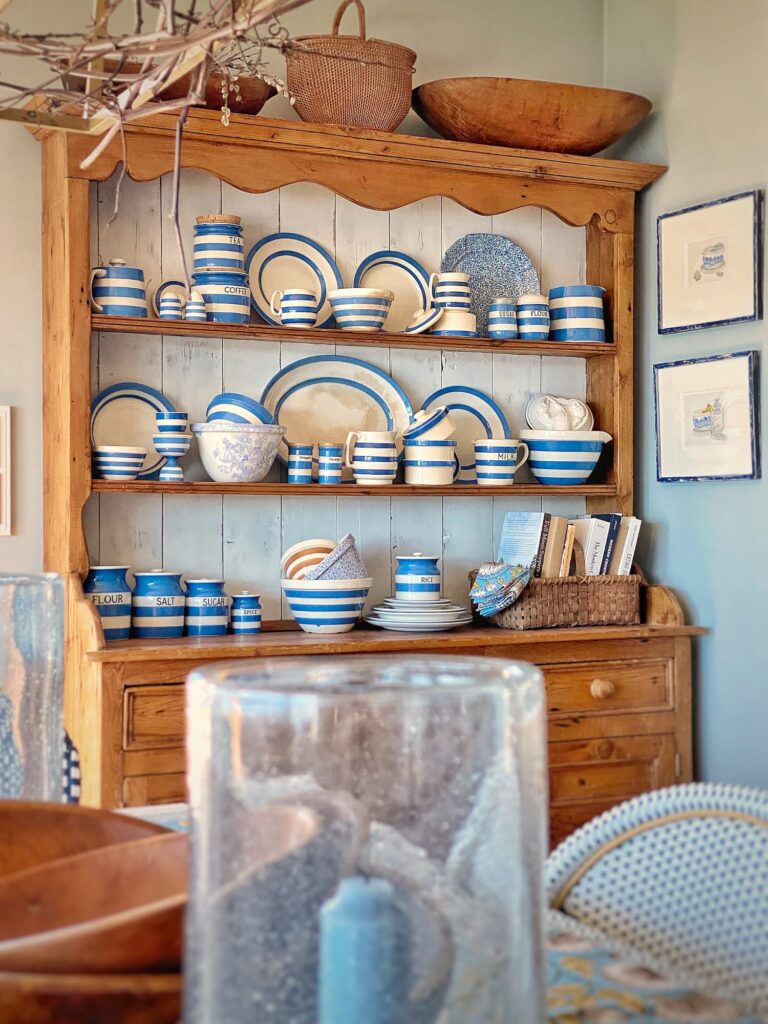
My Cornishware Collection began as unwittingly as most collections do — with the purchase of a single piece from a local antiques mall. I have a thing for blue and white stripes and found the small pitcher charming.
Shortly after I posted a picture of this and another Cornishware pitcher on my Instagram feed, someone who was selling off her large collection reached out to me. (How she could bear to part with it, I don’t know!)
It was the spring of 2020 and we were still mostly on lockdown. But I agreed to meet this stranger in the parking lot (outdoors!) of a New Hampshire state liquor store right off of I-95.
It all sounds rather nefarious, doesn’t it?!
I was determined to grow my collection. And grow it did — by leaps and bounds!
The haul I got that day still constitutes the majority of my collection, though I have since purchased a few additional pieces and received some as gifts.
I am no expert on Cornishware, so my collection consists of both both older and newer pieces. As with all my collections, I buy what appeals to my eye. I go for an interesting mix of shapes and sizes.
Starting Your Own Collection
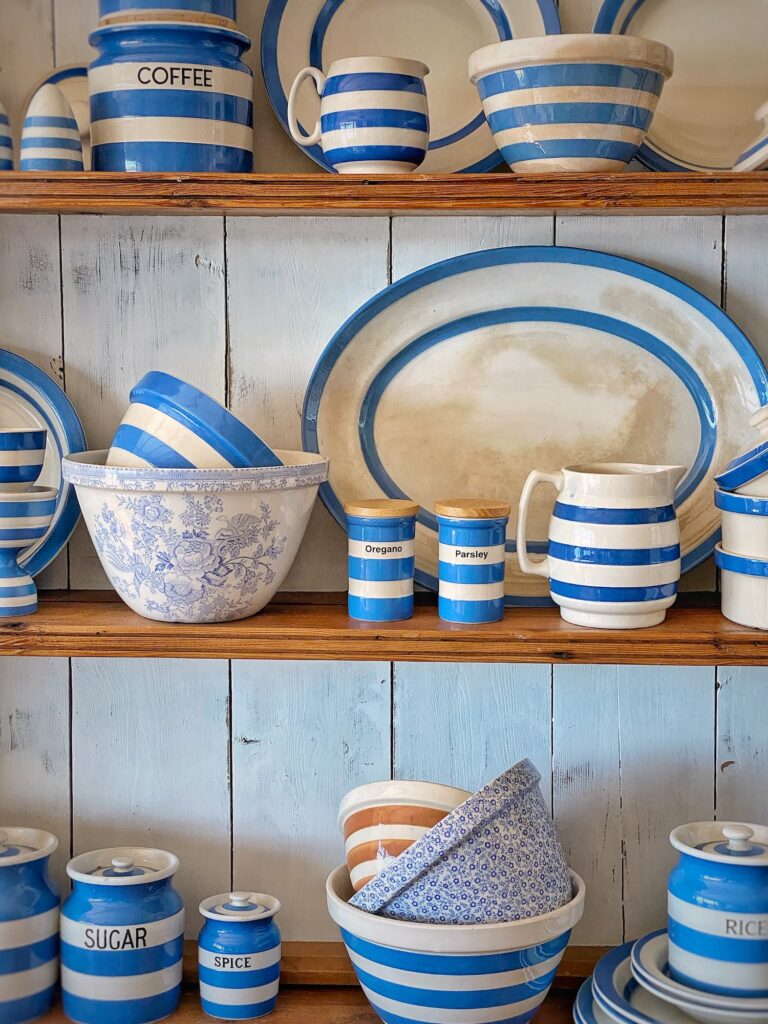
Vintage Cornishware can be hard to find in the U.S. I have found a few pieces at local antiques stores. You can also find it online on sites such as Etsy and EBay.
You can order new Cornishware directly from the Cornishware Website. Several times a year they have a seconds sale, with discounted prices on pieces that aren’t quite perfect.
Fellow blogger, New Englander, and Cornishware-lover Danielle from Finding Silver Pennies wrote about her experience ordering Cornishware directly from England in her post Collecting Cornishware. Danielle stores her Cornishware in a pine hutch similar to mine! Be sure to tell her I say “hi” when you head over to her blog!
This Year’s Hutch Display
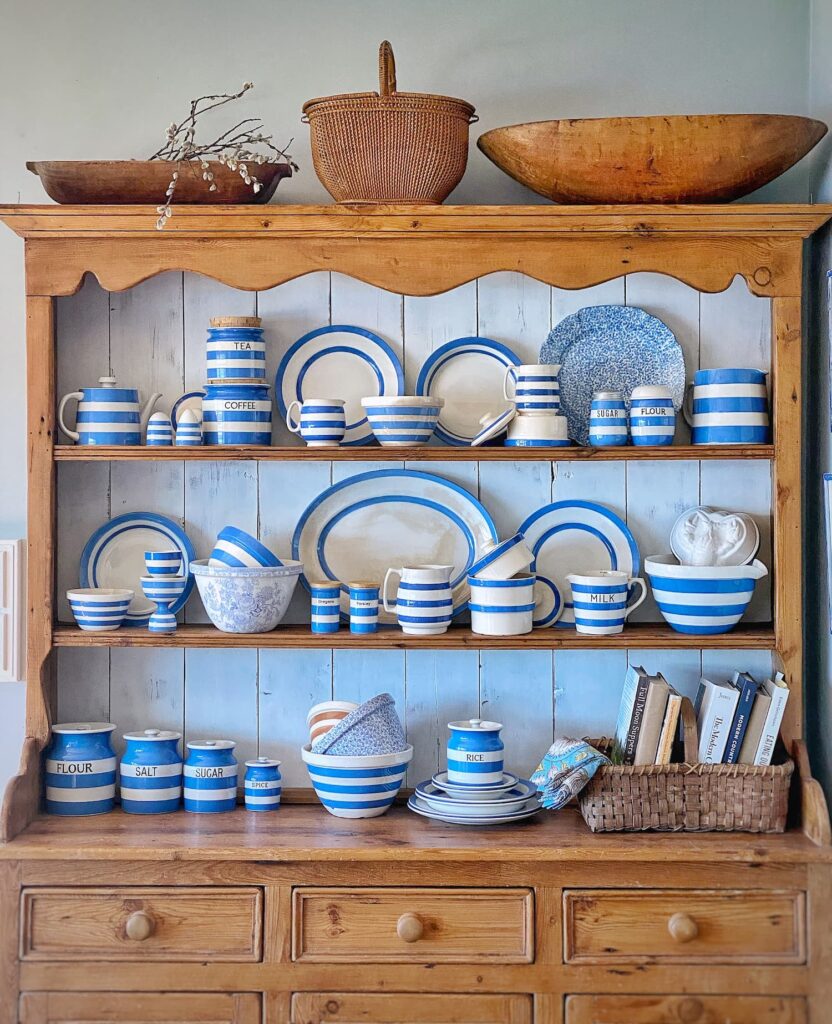

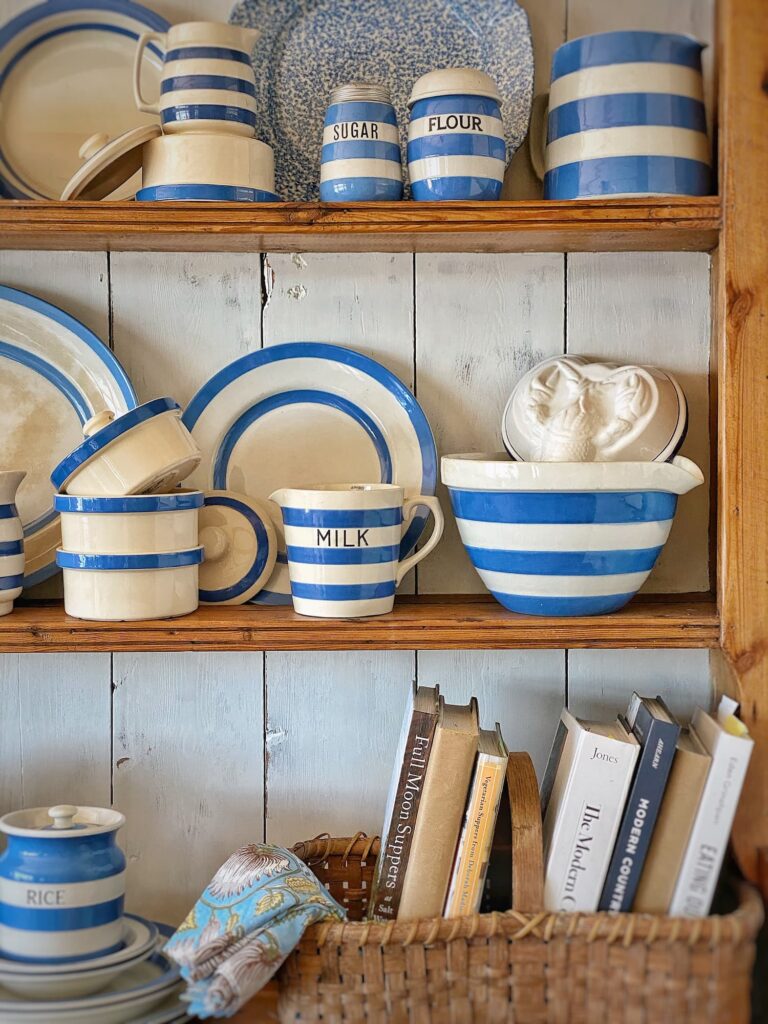
This is the fourth year I have displayed my Cornishware collection in the dining room hutch. This year I decided to go with a different arrangement!
I wanted something a little more free-flowing and organic. Kind of like if I had just stuck pieces up there without really thinking about it.
Except of course I did think about it — sort of.
Even when arranging a display on the fly, as I did here, you should keep in mind balance, size, and height.
I started with the plates and platters that form the background. Then I added the larger bowls and pitchers. Lastly, I filled in with the smaller objects.
Stack objects to add height! I like to stack bowls in a sort of haphazard way for a casual look and so that you get a peek of the inside bowl. Sometimes I need to add something inside the larger bowl to support the smaller one. Bubble wrap works well!
You will notice that I broke up the stripes with a few non-striped items. These help draw the eye through the arrangement and add interest.
For fun, I tucked a ceramic lobster mould into one bowl. Keep things playful!
For texture to contrast with all the shiny smooth pottery, I placed some cookbooks in the basket I used for my Easter table centerpiece. It, along with the wooden bowls and basket on the top of the hutch, adds warmth to the otherwise cool-colored display.
When I had everything on the shelves, I stood back and took it all in. I made a few tweaks, and then called it done!
Don’t sweat a casual arrangement like this — you don’t want it to be perfect!
Seasonal Decor
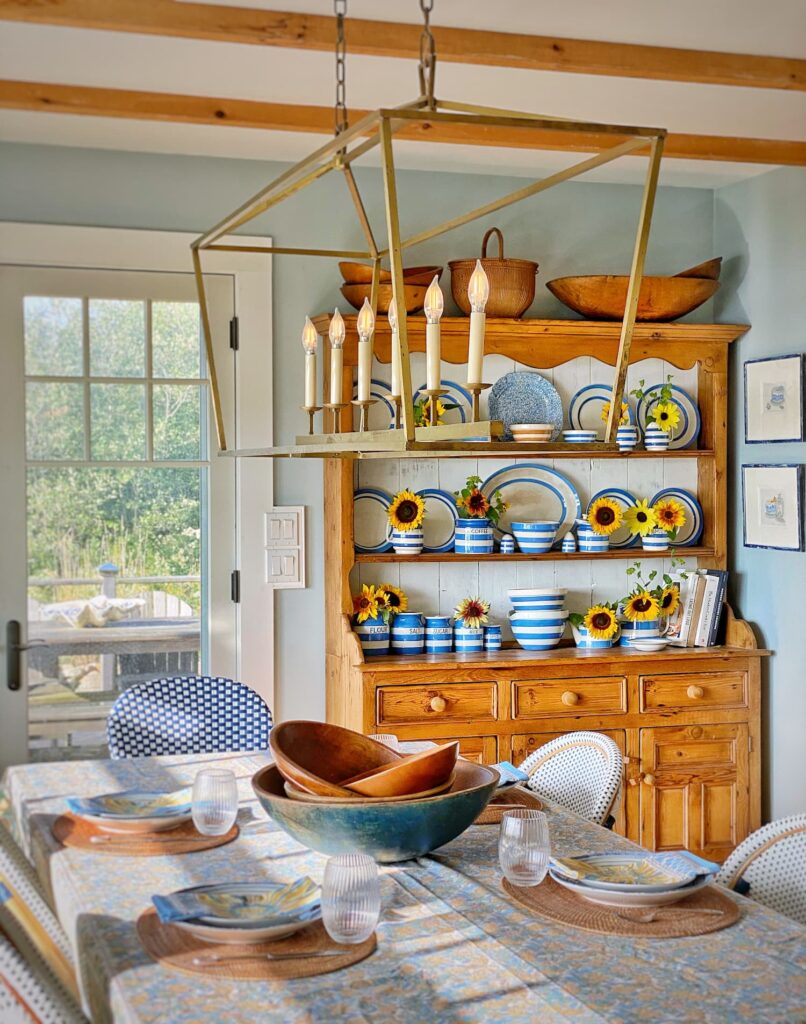
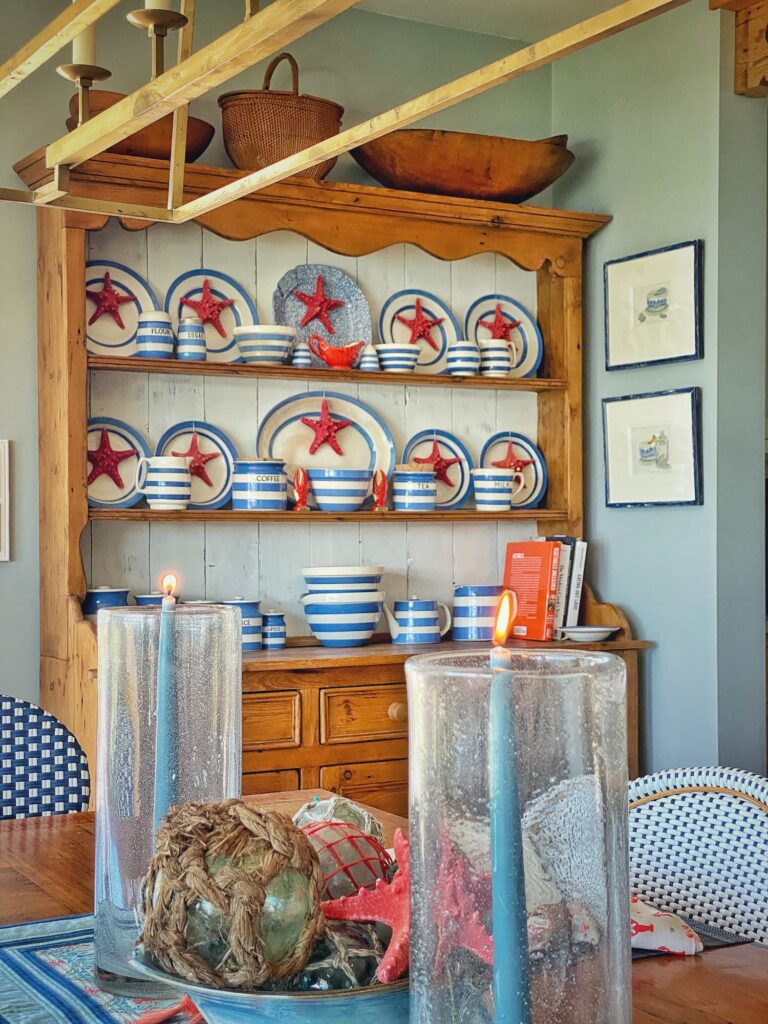
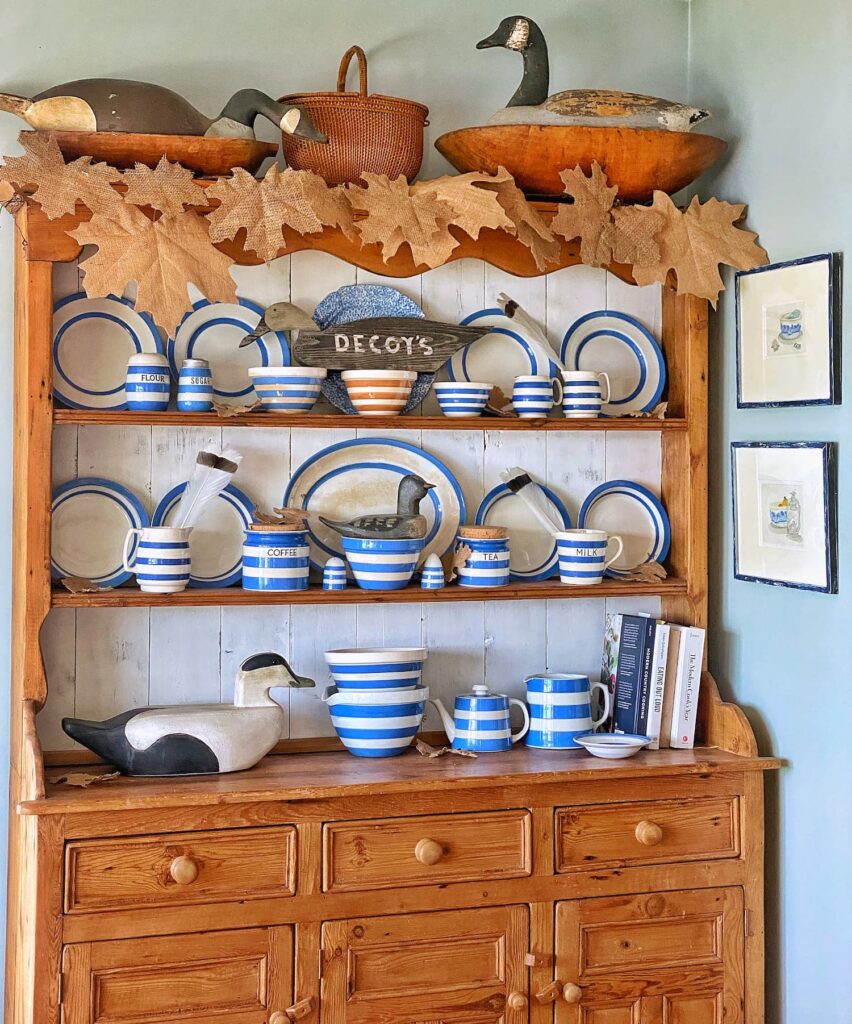
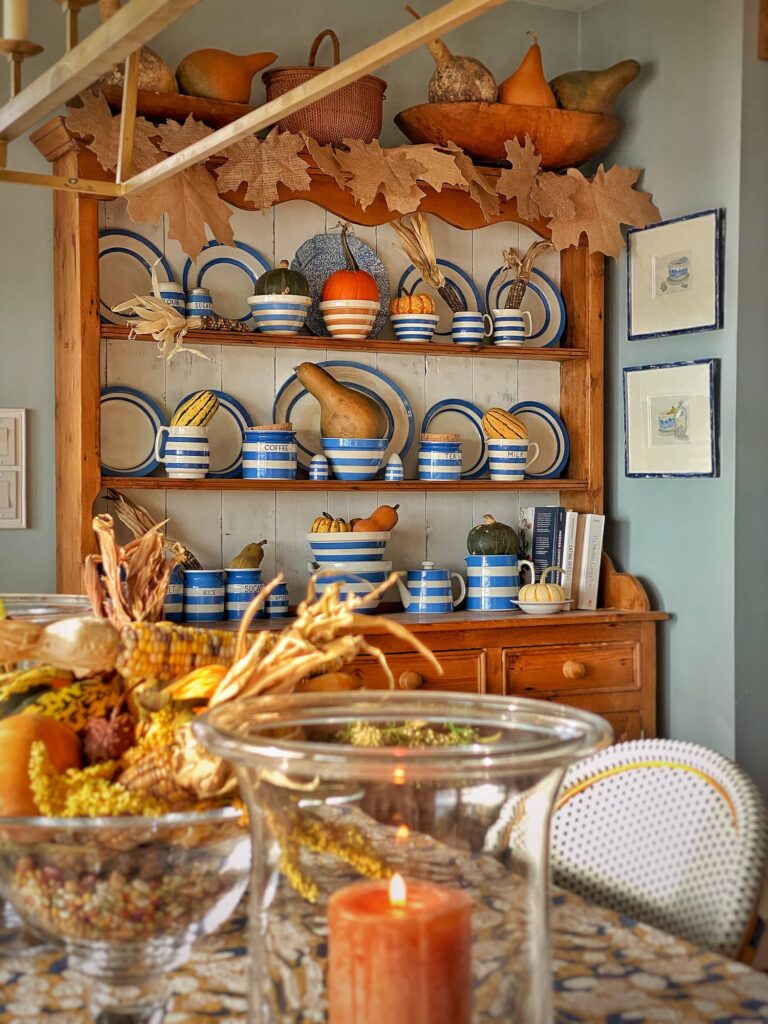
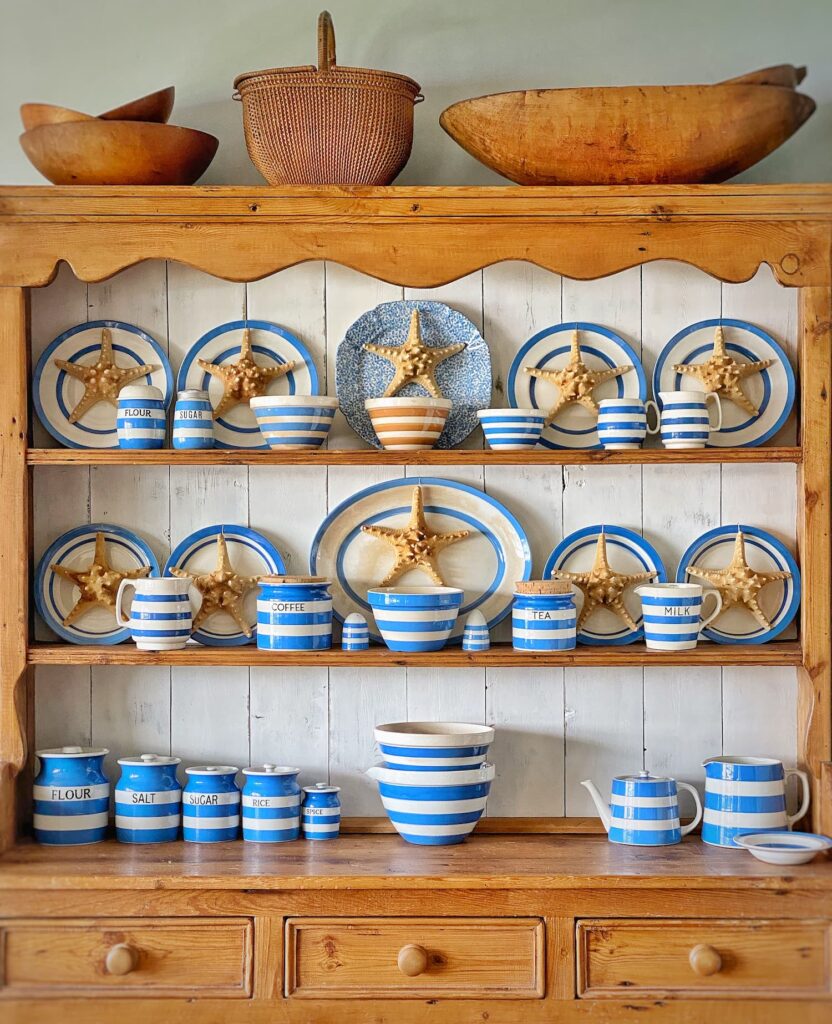
I will keep this Cornishware display in my hutch through at least Thanksgiving, adding seasonal touches as we head through the spring into summer and fall.
These are just a few of the ways I decorated it last year!
Which is your favorite? Or do you like it just plain like it is now?
The Coming Week

I don’t really have much planned for the week ahead.
The weather forecast doesn’t look great (I sound like a broken record….) but my favorite nursery is open and I hope to make it down there to get some pansies for pots on the front steps.
On Saturday I am meeting with my landscape guy to talk about plans for the slope leading down to the waterside lawn. We are also going to look at large rocks. It seems ridiculous, but we are going to need to purchase rocks. And dirt. Maybe I will buy some air and sunshine while I am at it… That said, I am excited about moving ahead with this project!
Lastly, my Minnesota daughter/SIL/grandson are visiting my D.C. daughter/SIL/granddaughter. I can hardly wait to see photos of the cousins’ first get-together!!
I hope you enjoyed this post on Cornishware and that you learned something new or got an idea or two to add beauty or creativity to your life!
Be well, friends!
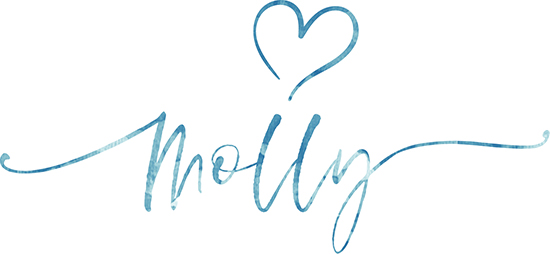

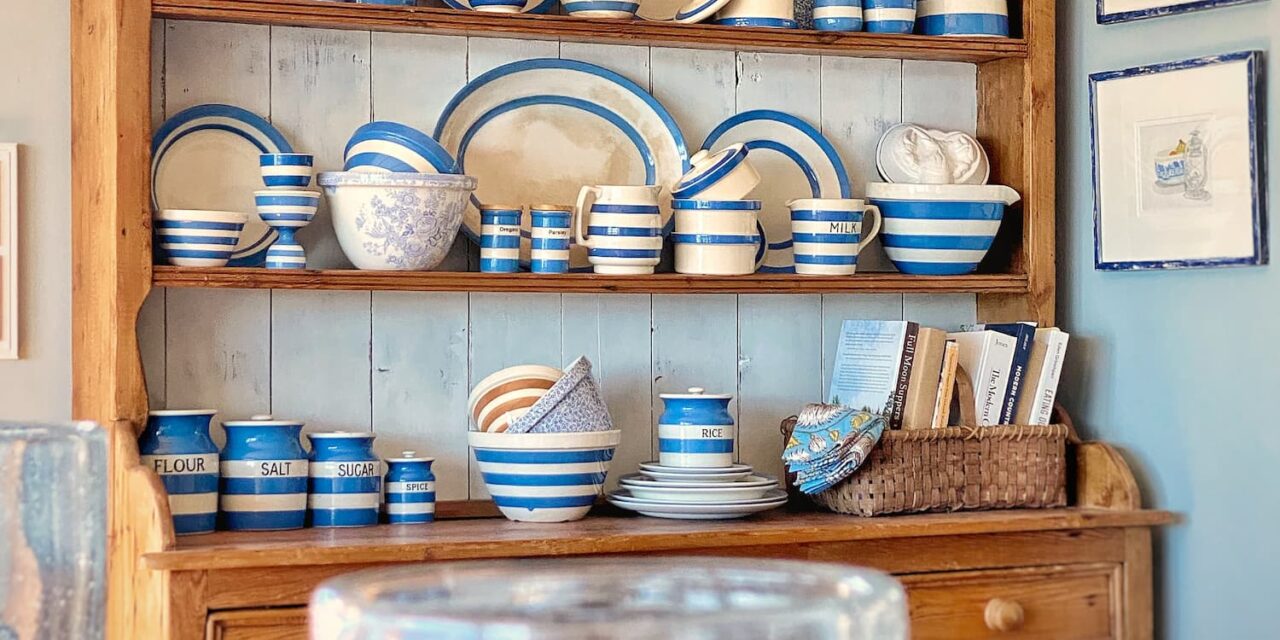
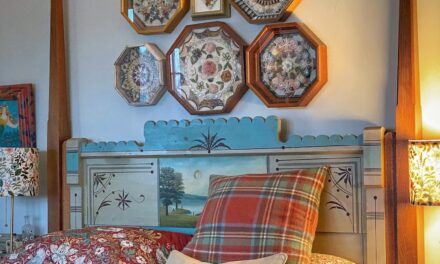

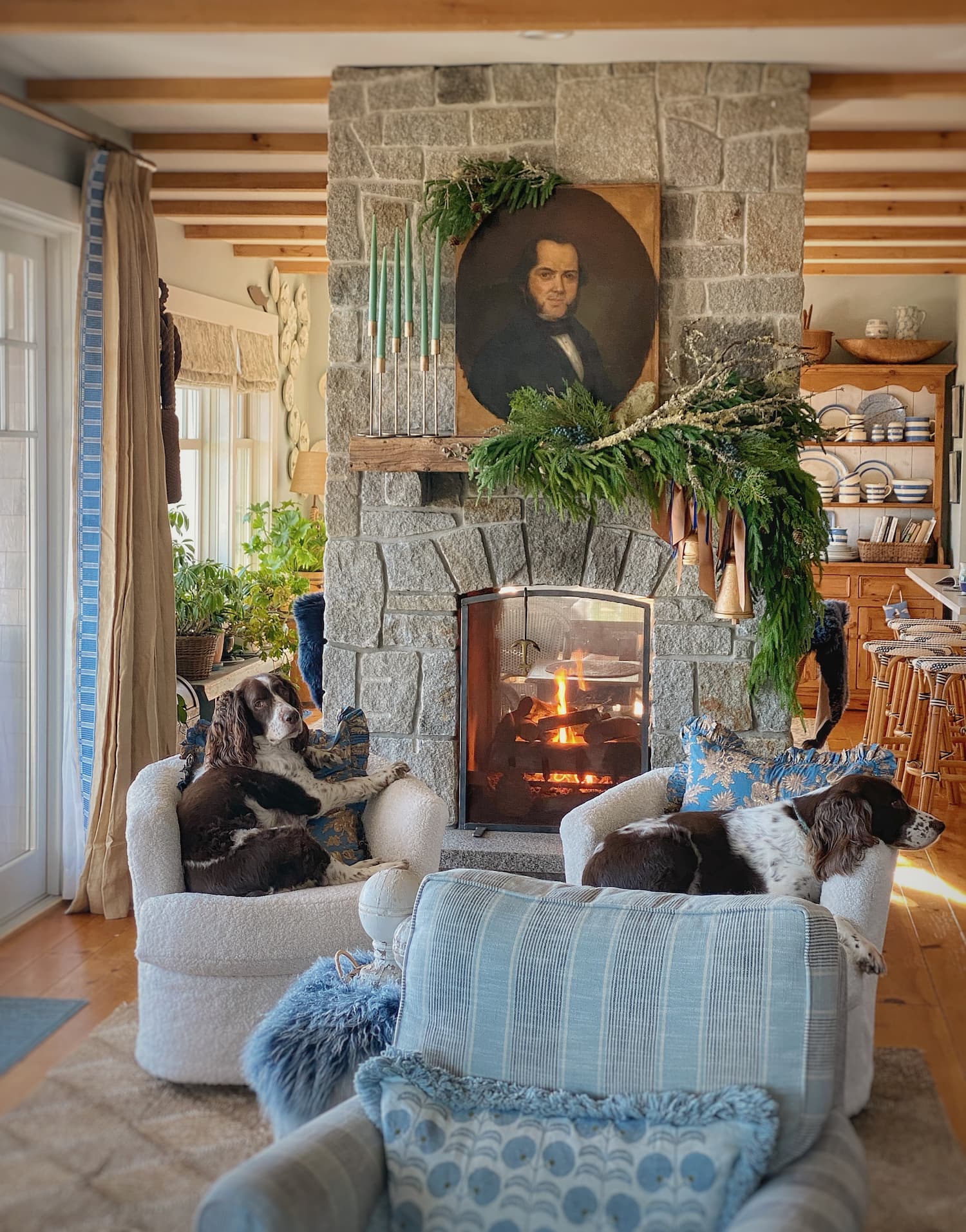

I love this. I hadn’t seen the striped crocks. They are so perfect for your gorgeous home. HUgs to you.
Thank you, Renae! I love the distinctive look of Cornishware. And some of the vintage storage containers have such quaint spices written on them — things we don’t use much anymore, haha!
This is a lovely collection. Thank you for sharing.
Thank you for taking the time to read my post and reaching out to say hello!
Learned a lot today.
Thanks for sharing!
I ordered candles, like your orange ones. Very pleased.
Want to order more. Please provide contact info again.
Sorry to bother you with this!
Thanks for reading, Ethel! I learned a lot preparing to write this post! The candles are from Danica Design. Here is the link to the website: https://www.danicacandles.com/
I meet customers there often. NH liquor store is a very common business rendezvous spot….easy, central and it works…..you do feel like a secret agent, but you get over it!
Your collection looks great, and summer shows up eventually. This is so typical, but somehow we all erase that calendar memory each year. (This coming week will water the plants?!?!)
I am over temps in the 30’s…. Oh well! And yes, it is a central meeting spot. But I still think it is weird that NH has state liquor stores RIGHT ON THE HIGHWAY. Doesn’t seem to quite jive with the whole no drinking and driving thing…
Funny thing….when bus tours from all over wrap up their day here, the last stop before going home is the NH Liquor store!
That must be quite the brochure!
Haha! Everyone is stocking up!
I have to agree with you about April ( but Apr. showers do bring May flowers)! At least the trees here in Burlington, Ontario, Canada bloomed last week (April 15, 2023). I record when the trees bloom each year and last year as if having been contained by Covid for at least two years wasn’t enough, the trees didn’t have any leaves until June 16th, 2022! So, just as you are doing I am putting out my summer decor!!! In anticipation Lol Happy Summer Molly !!!😃
Haha! Yes, happy summer, Kate! If spring isn’t going to show up, we might as well move straight to summer! We don’t generally get leaves on the trees until late May. It is at least nice to see the field turning green again!
Molly,
I wasn’t familiar with Cornishware, but it’s beautiful. It’s perfect in your coastal home. I’m sharing a link to your post tomorrow on Dirt Road Adventures.
Thanks, Rachel! It does seem to embody the spirit of our home here! I so appreciate you sharing my post in your Dirt Road Adventures tomorrow!
Thank you for introducing me to Cornishware. I have never heard of it before. My hometown of Louisville, KY also has handmade stoneware company called Louisville Stoneware that I have always loved. Handmade pottery is always beautiful to me. My favorite of your hutch pictures is when you added the red accents.
I have a thing for handmade pottery too! It has so much character! I do love the “lobster red” decor in the summer hutch!
Love the cornishware in your hutch,but especially the history behind it. Looking forward to seeing what you and your landscaper come up with. I know it will look natural and “All things Maine”. Just know that as we southerners are in full springtime mode now, we will be envious of your weather come July/August as we suffer from intense heat and humidity.
I know it will be instant cousin love on their first play date 🥰
Hi Julie! The cousin photos were fantastic! They even had matching outfits! And yes, July, August, and September are glorious here! You will hear no complaints from me when the ocean keeps the temps cool! I have to admit that I picked out some beautiful rocks yesterday, haha! I hope they will finally pull the slope area together! Have a great week!
Love your collections, Molly! Especially stripes. And I never tire of all the beautiful shots inside your dream house. Just boarded a plane so this is short and sweet. Happy weekend! xo
Thanks so much, Juliet! Have a great trip!
Thanks for this blog. Being a big lover of all things blue and white, as long as it’s the “right” shade of blue, I checked out the Cornishware website and I have to tell you yellow could be my favorite. What a ray of sunshine! Maybe you need just a pop of that to brighten up your day. The utensil jar in red would look so pretty at Christmas with greens in it.
You’re so right about the weirdness of the NH liquor store exit on 95! Easy off, easy on.
And have you read “Lessons in Chemistry” yet? Even my husband enjoyed it.
Have no fear, spring will appear!
Pam
Hi Pam! Thanks for reading! Yes, I agree — the yellow and white stripes are the happiest! (Our previous home was painted yellow and it always made me smile!) And yes, I think it is so weird to have a huge liquor store right on the highway! It is a very interesting “rest stop”, haha! I did read Lessons in Chemistry, and loved it! Do you have any other reading recommendations?!
Love what you do with your Cornish ware collection…especially with the sunflowers 🌻 You are very talented, Molly, with a great eye for balance and colour. We visited St Austell last year on our tour of the West Country… great brewery & pub there too!
I totally get your frustration with April. I announced to my husband in early April that there was much to do in our west coast BC 🇨🇦 garden . Well so much for those plans! A lot of damp, chilly windy weather which , when it was sunny, we tossed our gardening plans for walks and bicycle rides.
Forecast here on Vancouver Island is for 10 days of sun☀️😀.The narcissus beds are lasting longer due to the chilly weather, and the flowering trees haven’t opened their buds quite yet. With the windy days, that’s good. Rhododendrons and azaleas are ready to burst forth in May. Love spring … but it could have been more appealing this time.
Oh, thank you for your kind words. I do love arranging things. It brings such peace of mind and satisfaction! I am glad to know I am not alone in my frustration with the weather. May will be here soon and then things will finally start to wake up here! (Though the trees don’t leaf out until the end of May/early June…) Enjoy your stretch of sunny days. I hope you get both garden work and some bicycle rides in!
What a beautifully written post! Thank you for sharing your beautiful collection and how you display it. As always, everything you design is delightful.
Oh, thanks so much, Karen! This was a fun post to write — I learned a lot in preparation for it! I think the Cornishware is my happiest collection! It makes me smile!
Great post. I had never heard of Cornishware before. Thank you for the history lesson. Your home is lovely.
Hi Suzie! Thank you for reading my post and stopping by to say hi!
Hi Molly,
I can relate to your hope for more sun, less gray. I live in Southern California and our gloom is called June Gloom, with May Gray for added gray days. Haha.
That was such an enjoyable post on Cornish ware and its history. Thanks for that.
Good luck with the landscape work.
Enjoy your weekend.
Karen B.
Hi Karen! Yes, I know all about June Gloom and May Gray! I am ready for the bright sunny days of July, August, and September! I am glad you enjoyed my post! Thank you for reading and for taking the time to say hi!
Good morning Molly love this collection and I remember you going to NH to pick up some of these pieces. And I love Danielle’s blog. She’s the sweetest too🫶🏻💙
It was crazy times and a crazy drive to the NH liquor store for the pick-up, haha! Thanks for taking the time to read my post!
Like you said..how could someone part with an entire collection? But aren’t you lucky to be the recipient! I have spent WAY too much on UK shipping to buy myself a couple of seconds when they have their sales. SO hard to resist those sales sometimes. I did happen upon a vintage teacup and saucer at an antique store in Camden. Seeing those beautiful blue and white stripes as I turned the corner was like a beacon. Enjoy your stripey collection and remember those April shows bring May flower. Cheers!
Haha, I love your description of the blue and white beacon! It is always so fun when you find an unexpected treasure! May is just around the corner now. I am ready!
Love the spring arrangement in the hutch! We missed you this weekend but it was so fun to see the cousins together for the first time!!
Thanks, honey! I missed you all, but it was so fun to see the photos of all of you together! Loved the matching cousins outfits! I see matching t-shirts in their future for visits to Maine!
Well, you’ve taught me about cornishware today. It is stunning and looks so perfect in your Maine home! I’ll be sharing this in my weekly! Happy Sunday, Molly!
Hi Kim! These days it seems like maybe gray and white pottery would be more appropriate here, but I am holding out for those blue and white days, haha! Thanks so much for reading and sharing! Have a great week!
I loved learning about Cornishware and did visit the site to see the mesmerizing stripes being painted! Love the other colors but agree with you that the blue and white is the best! I like all of your hutch designs and love how you add some extra touches to keep up with holidays and changing seasons! I love this year – maybe best – since I love the quirky adds like the blue and white bowls and the lobster mold. But you did always add a little something like the bown bowls! You are so clever!
Hi Amy! I can’t imagine being able to paint those stripes — mine would be all wobbly and crooked, haha! I think I like this new arrangement better too. I always love things that are asymmetrical and a little more casual. I was getting the Cornishware from the basement and the lobster mould caught my eye. Perfect!
I love reading about your collections and regional weather conditions! I have a small collection of utilitarian southern pottery-jugs and crocks and such. I was going to suggest 2 books I read recently by Kristin Hannah: The Nightingale and The Four Winds.
Hi Jane — I am glad you don’t mind me whining about the weather here in the spring, haha! I promise I won’t gloat when we are in the 70’s this summer! Thanks for the book recommendations! I read The Nightingale and loved it! I have marked The Four Winds as “want to read”. It is always a pleasure to see you pop up in my comments!
Molly,
I love your Cornishware collection! And all of the seasonal touches! I’ve always loved it but don’t have any more room for another collection, it is fun to see yours though!
Have a wonderful week!
Thanks, Elizabeth! It is such a fun collection and just feels like summer here on the coast! Headed to check out your Saturday post now!
Love all of this Molly! We are taking our daughter and her kids to London in June and will be looking out for a store that sells Cornishware – it would look so great in my Kennebunkport home!
Hi Lee! You are right! It would look great in your home! Have a great trip to London. I hope you come home with some Cornishware!